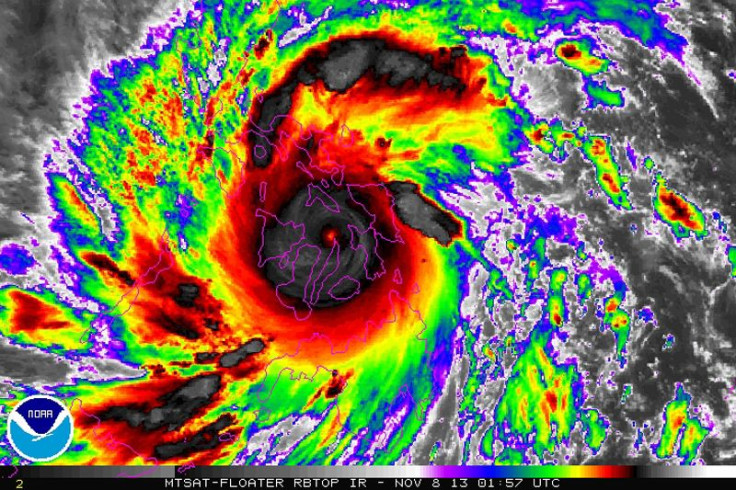UPDATE: Super Typhoon Haiyan, Strongest Tropical Cyclone On Record, Destroys Buildings And Homes, Causes Landslides, Kills At Least 3

Update 3:33 a.m. EST Friday: Typhoon Haiyan, known as Yolanda in the Philippines, has claimed at least three lives, damaged buildings, washed away homes and caused landslides, after it made landfall on the islands of Leyte and Samar -- about 600 miles southeast of Manila -- with winds close to 315 kilometers (196 miles) an hour, Voice of America reported. Many parts of the nation, made up of an archipelago of more than 7,000 islands, suffered disruptions in communications and power supply, the report said, adding that seven people had been reported injured so far and 29 provinces were affected by the super storm.
Update 9:24 p.m. EDT Thursday: The eye of the typhoon was located 62 km southeast of Guiuan, Eastern Samar (10.8°N, 126.2°E), with maximum sustained winds of 235 kph near the center and gustiness of up to 275 kph, based on all available data including Guiuan and Mactan doppler radar. It is forecast to move west/ northwest at 39 kph, according to www.pagasa.dost.gov.ph/.
Original story:
Super Typhoon Haiyan -- one of the strongest tropical cyclones in world history based on wind speed -- officially made landfall at 4 a.m. local time near Guiuan, on the Phillippine island of Samar. Contact has been lost with the city.
According to Dr. Jeff Masters of Weather Underground, the Joint Typhoon Warning Center reported that Haiyan had sustained winds of 195 mph (315 kph) and gusts at 235 mph (380 kph), making it the strongest tropical cyclone to make landfall in world history, breaking the previous record held by Hurricane Camille in 1969, which hit Mississippi with 190 mph (305 kph) winds.
As CNN notes, Haiyan is expected to travel across the islands of the Central Philippines over the next 18 hours before exiting into the South China Sea by Saturday. Philippine weather agency Pagasa says the storm will continue to be classified as a Super Typhoon as it moves through the islands.
In a speech, President Benigno S. Aquino III warned of the "calamity our countrymen will face in these coming days," according to CNN.
"Let me repeat myself: This is a very real danger, and we can mitigate and lessen its effects if we use the information available to prepare," said Aquino, who added that the government has three C-130 cargo aircraft ready, as well as 32 planes and helicopters.
"The effects of this storm can be eased through solidarity," he added.
As Dr. Jeff Masters of Weather Underground reports, Guiuan (population 47,000) likely suffered “catastrophic” damage when Haiyan hit. A 20-mile long storm surge also likely caused significant destruction. Tacloban (population 221,000) will also experience the wrath of Haiyan, as most of the city is at an elevation of less than ten feet.
The strongest part of Haiyan’s eyewall is now “battering” the southern part of the city, according to Masters, who also added that Haiyan’s winds, rains and storm surge will cause “widespread devastation” throughout Central Philippines.
Thousands of people have already been evacuated so far. According to CNN, the storm system, with a diameter of roughly 500 miles (800 kilometers), will affect roughly 25 million people.
© Copyright IBTimes 2025. All rights reserved.





















